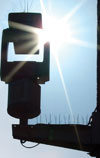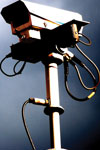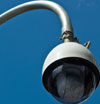

Down at the coalface, South Africa’s security integrators and installers understand the difference between the hype vendors sell and the reality customers buy. Hi-Tech Security Solutions got them talking at our first CCTV round table.
Hi-Tech Security Solutions invited a number of integrators and installers to join us in a round table, discussing the realities of implementing CCTV today. Specifically we focused on the IP versus analogue issue and the issue of bringing IT skills into the security market.
Starting out, we asked the participants to offer their opinion on the CCTV market in South Africa at the moment. Are we still seeing an IP/analogue battle or are South Africans sticking to their traditional mantra of ‘give me the cheapest, at any cost’?
Kevin Monk, CEO of Nkunzi Technisec, says the mid-market (which he defines as being an installation of up to 32 cameras) is very price driven, although the larger enterprise solutions buy and specify their solutions differently. He says IP is the way to go, although in most cases it is a matter of integrating new IP systems with existing analogue installations.

“We have done a lot of hardware installations converting or integrating analogue systems into IP systems and then grown them further onto IP, especially where our clients have already invested in 400 to 600 cameras onsite. They just have not got the money to take all 600 out and put in IP cameras.”
Looking ahead, Monk believes IP is going to deliver tremendous results in future and features like intelligent video are going to be a dominating factor in the market. “There are a few companies out there with real intelligent video solutions that deliver real value.”
From Camsecure’s perspective, the company decided to concentrate on IP about a year ago and this part of the business has grown to about 90% of the work the company does, according to Francois Malan. He says larger companies like IP because they can lay and manage their cabling themselves instead of having an additional coax cable that needs a third party to install and maintain it. Additionally, the constantly increasing power and capacity of IT systems attracts people to the IP platform because the next generation will always be able to do more with less.

Malan also attributed the growth in IP uptake to the emergence of H.264, which makes it easier to hook up many cameras to a network and use less bandwidth, as well as intelligent video analytics that happens on the camera, meaning you do not have to transmit the video all the time. Also, storage solutions are becoming cheaper, making it easier to store and/or analyse more video. He also raves about new megapixel technology, which offers image quality that is 'just fantastic'.

It is about results
Mike Barker, from Mike Barker & Associates, says the issues he is seeing in the CCTV market are certainly megapixel cameras, not only in terms of better images, but from the perspective of gathering evidence that is good enough to return a conviction in court.

Rob Anderson, MD of Rob Anderson & Associates, agrees with this assessment, saying the current situation in the CCTV market is that as much as 95% of video material viewed after a crime is useless when it comes to prosecution – irrespective of whether it is IP or analogue footage.

He adds that the reason we are talking about IP and analogue is because there are huge marketing budgets being spent on promoting IP and clients automatically think it is the best thing around at the moment. Says Anderson, “I always say, live through the phase where it is in design and everything is changing, and make a move once it is matured.”
And there are some interesting challenges associated with IP today. However, from an integrator’s perspective, Sitronix’s Steve Mason says IP offers a much easier and more practical platform to work and integrate different systems on, such as access control because it is a common protocol. He says avoiding proprietary is a must if you want to make installation, maintenance and expansion as close to hassle free as possible.

Here it is all about standards. Specifically adopting a single standard everyone adheres to. IP is good in this regard as it is a set standard that nobody fiddles with.
It was a concern among many of the participants that integrating analogue and IP camera systems was not a craft many companies excelled in, although many out there claim to be experts. Some mentioned the tendency to answer tenders by throwing IP cameras and technology into existing analogue solutions “and expecting something to come out the other end; what we should be doing is working very closely with the network administrators and IT people to ensure that whatever sits on their network is designed to and to standard,” explained Malan.

Design considerations
When looking at an installation, IP or not, it is important to first find out what the client wants and whether they can afford it. Monk says many clients start out wanting video that will stand up in court from all their cameras, but change their minds when the costs are calculated. “Focus expensive resources on areas in which they can deliver a return.”
Anderson explains that to get past this impasse, his company sits down with clients and creates a job description per camera. This generally ends the debate about what needs to be done in each position (See article: 'Does your camera have a job description?')
And when it comes to job descriptions, as always, the human factor needs to be considered. Ensuring the human element is also well designed and monitored is important to prevent errors in CCTV installations. IP is simple. Installing a CCTV camera is simple. Installing cameras to achieve certain results over time is not simple if your people are not trained correctly.
Anderson recalls issues where crimes were committed in areas under surveillance, but there was no CCTV footage because, in one instance, the network administrator made a small adjustment to the network and lost the cameras because it was not his job to change settings on the CCTV equipment; in another a server’s software licence expired, shutting the cameras down.
Gregory Collyer, Dimension Data’s security solutions architect, says it is a matter of trust and training. If you can trust your IT people with securely transmitting your banking transactions you can surely trust them with your CCTV. The issue is in the training, ensuring they know and take responsibility for all devices on the network. In an integrated or converged solution, both sides need to be aware of their impact on each other and have processes in place to handle change control.

As an example of effective cooperation between IT and security personnel, Monk offers an example of a site in KZN where cameras use the existing IT infrastructure. The company in question runs a 1 Gb network with another 1 Gb redundant system. The 128-camera installation has been assigned 512 Mb (half of the capacity) on the redundant network and only uses about 65% of it at the moment. Both sides are happy because the design was handled professionally and all parties trained in making it work.

A question of skills
On the topic of training, the world at large is always complaining about the lack of skills, even in the current recession where thousands are being retrenched. Fortunately, the security industry seems to be in a better situation when it comes to the skills issue – for now.
However, the convergence between the IT and security worlds is producing new requirements in terms of the skill sets required in the industry. Instead of looking to the IT market to import skills, most security companies are training their own due to costs and an understanding of the importance of quality work. In IT, installing the network correctly will see it delivering the service it is supposed to, the same does not apply to security in general and CCTV specifically.
Monk says Technisec, among other larger integrators, do not have many problems in the skills department at the moment. “I think we have grown our companies in the market to an extent, through our skills base, because our greatest assets within our businesses are our staff and skills. All the integrators out there can access the same equipment, it is through our skills that we differentiate ourselves and add value to clients.”
He does note, however, that poor skills becomes a problem for the industry when the bakkie brigade comes into play. These businesses lack the skills to deliver a consistently higher quality of service, but the vendors still supply them with product – a sale is a sale, no matter what the end customer’s experience is. The barriers to enter in the industry are very low, resulting in quality and service issues.
“It has become a terrible industry with the convergence of security and IT,” adds Camsecure’s Malan. “I mean this in the sense that there are so many people selling IP out there and implementing solutions they do not understand, or do not have enough knowledge in that we are all tarnished with the same brush of incompetence.”
Security people are implementing networked cameras, while they do not understand networking’s game. On the other hand, Malan notes that there are also IT companies installing CCTV systems without understanding how the cameras function from a security point of view. This can lead to poor coverage and inadmissible evidence.
On the bright side, overlapping markets creates a niche that qualified people can do well in. “I think there is a lot of potential there, but skills are an issue, as are people who do not have the skills but try to do the job anyway.”
Fortunately, Monk notes that things are changing and suppliers are starting to insist their installers are certified for certain products. This, of course, affects the whole market, especially when it comes to new IT-based technologies. Technisec recently sent 22 people on the basic and advanced networking courses offered by Duxbury.
“All our in-house technical staff have these qualifications and we are continuously trying to stay abreast of changes in technology and products,” says Monk. “On the IT side Technisec has permanent employees in place, such as a script developer and a networking professional. We had to put them in place because the IT companies out there might know about IT, but they generally know little or nothing about security.”
Sitronix’s Mason noted that, from an integrator’s point of view, using an IT infrastructure has become par for the course. He promotes the idea of training from within and migrating existing skills to accommodate the IP platform. In this way companies end up with the best of both worlds, instead of taking an expensive IT person and trying to integrate them into the operational processes of the security world.
Barker adds that the skills problem we face in this country is no different to the issues anywhere else in the world. “We definitely do have a shortage of technical people in the computer and also in the security industry.”
He is also in favour of standards, promoting the establishment of entry-level standards for people coming into the industry in order to measure their capabilities and rate their competence in various areas.
Collyer adds that it is the customer that suffers from poor skills, implementation or understanding of what security systems are supposed to do. He therefore supports a set of basic standards or certifications for entrants to the industry, but notes that consultants have a larger role to play in the process.
“Consultants need to proactively involve clients in the design of systems to ensure that there are not false expectations of what the end result will deliver,” Collyer says.
Differentiation of skills
Mike Smiles, MD of Masc Solutions has another take on the situation, using the UK as an example. In South Africa, anyone can enter the industry and handle an entire system installation, from consulting to cables to cameras. This means the installers are assumed to have all the skills and certifications required for all the tasks at hand.

In the UK, when fire alarm systems are installed, all the cabling is done by the electrical contractor to a design prepared by an engineering company. The electrical contractor does all the wiring, connects all the detectors up, and so on. This means the consultant, the installer and the customer have an assurance that the wiring is done to the regulated standards and there is someone to hold responsible if something goes wrong.
An approach like this will put some restrictions on the current fluctuations in the market. Many IT people see the security industry as a lucrative sideline, thinking a good network is what it is all about. If there were standards in place, the industry could protect itself and its customers from cowboys, or at least allow clients to make informed decisions when hiring people and companies – choose a quality or low cost solution.
However, wanting standards and going through the process of getting them in place is not a simple task. Anderson points to the electrical industry as an example.
Do standards work in security?
“If you look at the electrical industry and think how the standards developed, you will see it developed by association between universities, technikons, the consulting industry, and the installers and manufacturers. Over the years, they got together, and created standards that made everything work. Security does not have that luxury. There are very few consultants in South Africa that have specialised in security and the educational institutions are behind the game. And that is not even mentioning getting buy-in from a significant body of installers and manufacturers.”
Additionally, security installations have many problems when it comes to standardisation. In, for example, the fire detection market, there are regulations covering almost everything: where you would position a fire-detector, how far between the detectors, how much coverage and so forth.
Smiles says that with security, while certain installation standards can be defined, you can not standardise where cameras should be placed, what resolution to use, where to locate an access control card reader and so forth. These issues rely on the consultants and installers to a greater degree as they know what the client wants, needs and can afford.
Of course, Smiles also notes that the bakkie brigade plays a role here too, with people using the cheapest products and labour to get in the lowest quote, irrespective of the ultimate result. There are, of course, good installers who work alone or in small companies and do a professional job, but there are also many who give the industry a bad name by cutting corners and vanishing when the customer needs service.
Both Malan and Barker thought allowing the security industry’s standards to be pushed by the insurance companies might help. As with alarm systems, for example, the insurance companies have the power to insist that certain standards apply if claims are to be honoured.
“It is one thing putting the standards in place, it is the other thing policing it,” says Monk. “It is a wonderful thing for us to sit around, and say, these are the standards that we are going to adhere to. But, I think, we have got to look past that and say, who polices that.
“That is more important than the standards themselves. The Health and Safety Act, for example, forces us to adhere to certain standards in our business and when we are on site. Perhaps that is where we can begin in the security industry, to ensure every company is compliant to the Health and Safety Regulations because that is a set, regulated standard already in place and it is going to cost each company a fair amount of money to get themselves up to scratch.”
Counting the cost
While meeting standards costs companies money, so does the IP/analogue debate. There can be no doubt that IP CCTV is the standard for the future, but companies need to understand what they need and what they are getting before opting for an IP solution because it is the latest thing.
A poor CCTV installation, no matter what technology is used is going to cost a lot of money while providing no return. A CCTV installation that meets the needs of the company will also cost, perhaps not as much since often a cheap camera could suffice in various situations, or perhaps it would cost more because of the need for thermal imaging or some horrendously expensive camera, but the returns will repeatedly justify the cost if the design and consulting stage is handled correctly.
Then there is the cost of human resources, both security and IT, or for those lucky enough to prepare for convergence, single resources with both skills. Since good skills are getting more expensive all the time, cross-skilling and up-skilling existing company resources is a cost-effective decision.
However, looking at security and CCTV in particular in terms of cost alone is a costly error in itself. Spending money on any service or solution should be determined by the needs of the company and the functionality of the solution offered.
When CCTV is designed and tailored to each company’s requirements – as opposed to a vanilla implementation from a cheap supplier – the results in terms of safety and security more than pay for the implementation. In many cases, such as retail, reductions in theft more than cover the cost of implementing the system.
The simple fact is IP solutions will pervade this market for the medium term before they subsume analogue altogether. This means integration with the existing IT systems is not negotiable as both sides need to work together in a standardised, functioning environment. Getting this magic formula right will result in getting the returns you need out of both your security and IT environments – and that is good business.

© Technews Publishing (Pty) Ltd. | All Rights Reserved.